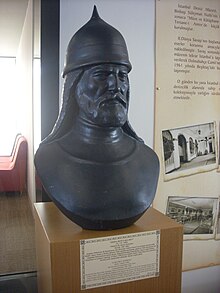Tzachas
| Tzachas Çaka | |
|---|---|
| Bey | |
 Modern representation of Tzachas in the Istanbul Naval Museum | |
| 1st Bey of Smyrna | |
| Reign | c. 1081 ‒ 1093 |
| Successor | son of Tzachas (name unknown) |
| Born | Unknown |
| Died | 1093 Sultanate of Rum (modern-day Turkey) |
| Issue | Ayşe Hatun |
| Religion | Islam |
Tzachas (
Life
Very little is known about his life, and that mostly from only one source, the
According to the Alexiad, Tzachas was originally a raider, who was taken as a prisoner by the Byzantines during the reign of
From ca. 1088 on, he used his base at
In 1090/91, the Byzantines under Constantine Dalassenos recovered Chios.[3][5] Undeterred, Tzachas rebuilt his forces, and resumed his attacks, even proclaiming himself emperor (basileus) and seeking to conclude an alliance against Alexios I with the Pechenegs in Thrace for a joint attack on Constantinople.[2][3] In 1092, Dalassenos and the new megas doux, John Doukas, were sent against Tzachas, and attacked the fortress of Mytilene on Lesbos. Tzachas resisted for three months, but finally had to negotiate a surrender of the fortress. During his return to Smyrna, Dalassenos attacked the Turkish fleet, which was almost destroyed.[3][6]
According to the Alexiad, in spring 1093, Tzachas attacked the port of
Legacy
The modern Turkish Naval Forces officially consider 1081, the capture of Smyrna by Tzachas, as their founding date.[9]
See also
Footnotes
- modern Turkish alphabet "Çaka", prevailed especially in modern Turkey, after Akdes Nimet Kurat used it in his work Çaka: Orta Zamanda İzmir ve Yakınındaki Adaların Türk Hakimi, Istanbul, 1936, ... yüksek siyasî ve askerî görüş sahibi olarak büyük önem taşıyan bu bey'in adının gerçek söylenişi henüz tamamen kesinliğe kavuşmuş değildir. Bu hususta şimdiye kadar üç ihtimal ileri sürülmüştür: Çaka, Çağa, Çakan. AN Kurat'ın bunu "Çaka" kabûl ederek eserini de "Çaka Bey" diye adlandırması, özellikle memleketimizde Çaka şeklinin yaygınlaşmasına yol açmıştır denebilir. (Tarih Dergisi, Cilt 20, İstanbul Üniversitesi Edebiyat Fakültesi, İbrahim Horoz Basımevi, 1983, p. 56.)
References
- ^ Alexander Daniel Beihammer, (2017), Byzantium and the Emergence of Muslim-Turkish Anatolia, Ca. 1040-1130, p. 272
- ^ a b c d e Mallett 2013
- ^ a b c d e f g Brand 1991, p. 2134.
- ^ Anna Komnene. Alexiad, VII.8 (Dawes 1928, p. 183).
- ^ Anna Komnene. Alexiad, VII.8 (Dawes 1928, pp. 183–187).
- ^ Anna Komnene. Alexiad, IX.1 (Dawes 1928, pp. 214–217).
- ^ Anna Komnene. Alexiad, IX.3 (Dawes 1928, pp. 219–220).
- ^ Anna Komnene. Alexiad, XI.5 (Dawes 1928, p. 281)
- ^ "Deniz Kuvvetleri Komutanlığı Tarihçesi" [History of the Naval Forces Command] (in Turkish). Turkish Naval Forces Command. Archived from the original on 24 January 2021. Retrieved 8 February 2022.
Sources
- Brand, Charles M. (1991). "Tzachas". In ISBN 0-19-504652-8.
- Dawes, Elizabeth A., ed. (1928). The Alexiad. London: Routledge & Kegan Paul.
- Mallett, Alex (2013). "Çaka Bey". In Fleet, Kate; ISSN 1873-9830.
Further reading
- Brand, Charles M. (1989). "The Turkish element in Byzantium, eleventh-twelfth centuries". Dumbarton Oaks Papers. 43: 1–25. JSTOR 1291603.
- Savvides, Alexis G.C. (1982). "Ο Σελτζούκος εμίρης της Σμύρνης Τζαχάς (Çaka) και οι επιδρομές του στα μικρασιατικά παράλια, τα νησιά του ανατολικού Αιγαίου και την Κωνσταντινούπολη". Χιακά Χρονικά (in Greek). 14. Athens: 9–24.
- Savvides, Alexis G.C. (1984). "Ο Σελτζούκος εμίρης της Σμύρνης Τζαχάς (Çaka) και οι επιδρομές του στα μικρασιατικά παράλια, τα νησιά του ανατολικού Αιγαίου και την Κωνσταντινούπολη". Χιακά Χρονικά (in Greek). 16. Athens: 51–66.
- Savvides, Alexis G.C. (2000). "Can we refer to a concerted action among Rapsomates, Caryces and the Emir Tzachas between A.D. 1091 and 1093". Byzantion. 70: 122–134.
